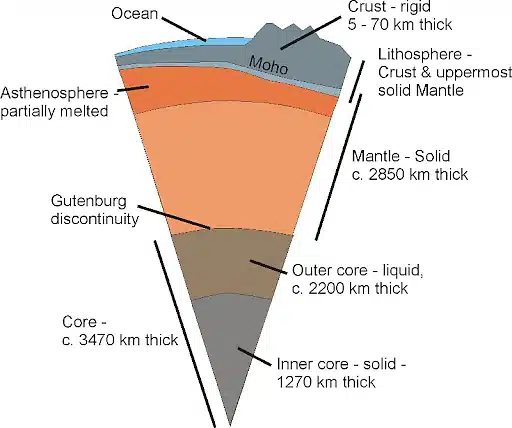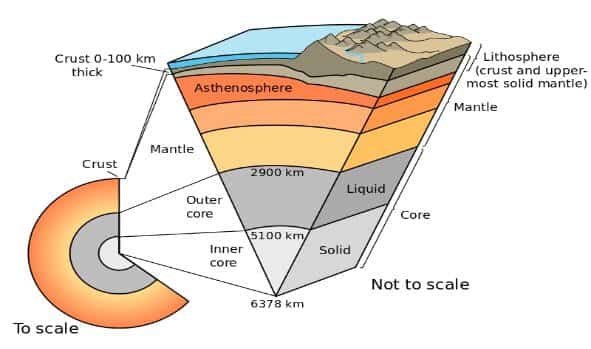- The Earth can be divided into one of two ways: mechanically or chemically.
- Mechanically (or rheologically) meaning the study of liquid states – it can be divided into the lithosphere, asthenosphere, mesospheric mantle, outer core, and the inner core.
- But chemically or by composition, which is the more popular of the two, it can be divided into the crust, the mantle (which can be subdivided into the upper and lower mantle), and the core – which can also be subdivided into the outer core, and inner core.

Sources to study the earth’s interior
The sources which provide knowledge about the interior of the earth may be classified into 2 sources-
- Direct sources
- Surface rock
- Volcanos
- Mining Projects
- Drilling Projects
- Deep Ocean Drilling Project
- Integrated Ocean Drilling Project
- Indirect sources
- Temperature and pressure variation
- Seismic activities
- Meteorites
- Gravitation
- Magnetic field
Direct Sources of Earth’s Interior
These materials are available normally at the surface of the earth and are sourced from:
- Earth’s Surface: Surface rock is readily available at the surface of the earth. By observing these rocks, we can know the form of material that can be found up to a certain depth.
- Volcanoes: Volcanic material that gets out after an eruption is readily available to us for observation. Since these materials come up from great depth, therefore, the quality of this material at great depth can be analyzed directly. However, the accurate depth of material can’t be ascertained.
- Material obtained from Mining and Drilling areas: From Mining and Drilling areas, many materials can be sourced for analysis. These materials reveal the nature of material available at a certain depth. From mining, it is easy to deduce that pressure and temperature increase from the surface towards the interior deeper depth. Also, the Density of the material increases from the top surface to the interior bottom.
Indirect Sources of Earth’s Interior
- Since the Direct source materials can be accessed up to a certain depth. Beyond that depth, it is not possible to know the quality of interior the earth has. To overcome this, Scientists use technologies like the application of gravitation, magnetic and seismic knowledge to know the interior of the earth. Further, scientists also consider meteorites as an indirect source because, once, it was part of a planet.
- Meteorites: Meteorites are found in space and seldom reach the earth. When it reaches the earth, It is available for analysis. Meteorites are not from the interior of the earth; therefore, it has an indirect source to acquire the interior of the earth because scientists assume that Meteorites were once part of the planet, therefore, their structure and material is similar to the earth.
- Gravitation force: Gravitational value is not the same across all the latitudes. The differences in gravitational value show the uneven distribution of mass of material within the earth.
- Magnetic force: Magnetic survey of the earth reveals the distribution of magnetic materials available in different parts of the earth.
- Seismic knowledge: It provides information what’s the state of the interior of the earth. Whether it’s solid, liquid, or in gaseous form. The technology revealed that the mantle is liquid, the outer core is liquid but the inner core is solid.
Structure of the Earth’s interior
The structure of the earth’s interior is made up of several concentric layers. Structure of Interior Of The Earth is divided into three layers-
- Crust
- Mantle
- Core

Crust
- The crust is the outermost solid part and a thin layer of the earth with a total thickness normally between30-50 km.
- The thickness of the crust varies under the oceanic and continental areas.
- Oceanic crust is thinner (5-30 km thick) as compared to the continental crust(50-70 km thick).
- The continental crust is thicker in the areas of major mountain systems.
- It is as much as 70 -100 km thick in the Himalayan region.
- It is 0.5-1.0 percent of its volume and less than 1% of its mass.
- The temperature of the crust increases with depth, reaching levels of around 200 °C to 400 °C near the mantle-crust boundary.
- In the higher region of the crust, the temperature rises by up to 30 degrees Celsius for every kilometer.
- The crust’s outer layer is made up of sedimentary material, and beneath it are acidic crystalline, igneous, and metamorphic rocks.
- Basaltic and ultrabasic rocks make up the crust’s lowest layer.
- The temperature of the crust rises with depth, reaching levels of around 200°C to 400°C near the mantle-crust boundary.
- In the higher region of the crust, the temperature rises by up to 30 degrees Celsius for every kilometer.
- The crust’s outer layer is made up of sedimentary material, and beneath it are acidic crystalline, igneous, and metamorphic rocks.
- The lighter silicates — silica + aluminum (also known as sial) — make up the continents, while the heavier silicates — silica + magnesium (also known as sima) — make up the oceans [Suess,1831–1914, this categorization is now obsolete (out of date)].
- Lighter (felsic) sodium potassium aluminum silicate rocks, such as granite, make up the continental crust.
- On the other hand, the oceanic crust is made up of thick (mafic) iron magnesium silicate igneous rocks like basalt.
- Mohorovicic (Moho) discontinuity forms between lower crust and upper mantle.

The most abundant elements of the Earth’s Crust
| Element | Approximate % by weight |
|---|---|
| Oxygen (O) | 46.6 |
| Silicon (Si) | 27.7 |
| Aluminum (Al) | 8.1 |
| Iron (Fe) | 5.0 |
| Calcium (Ca) | 3.6 |
| Sodium (Na) | 2.8 |
| Potassium (K) | 2.6 |
| Magnesium (Mg) | 1.5 |
Lithosphere
- The lithosphere is the earth’s rigid outer layer, with a thickness ranging from 10 to 200 kilometers.
- It consists of the crust as well as the upper part of the mantle.
- The lithosphere is divided into tectonic plates (lithospheric plates), which move and create large-scale changes in the earth’s geological structure (folding, faulting).
- The primordial heat left over from the planet’s birth, as well as the radioactive decay of uranium, thorium, and potassium in Earth’s crust and mantle, are the sources of heat that drive plate tectonics.
Asthenosphere
- It lies below the lithosphere extending up to 80-200 km.
- The rigid lithosphere can easily move over it because the asthenosphere is soft and plastic.
- It’s vicious, brittle, and ductile, and its density is higher than the crust.
- During volcanic eruptions, it is the primary source of magma that rises to the surface.
- The lithospheric shell is divided into large pieces called lithospheric plates. These plates can separate from one another at one location, while elsewhere they may collide in crushing impacts that raise great ridges.

Mantle
- The portion of the interior beyond the crust is called the mantle.
- The mantle extends from Moho’s discontinuity(35 km) to a depth of 2,900 km.
- It equates to roughly 83 percent of the earth’s volume and 67 percent of its mass.
- The upper portion of the mantle is called the asthenosphere.
- The asthenosphere reaches beyond the lower mantle. It is completely solid.
- The crust and the uppermost part of the mantle are called the lithosphere. Its thickness ranges from 10-200 km.
- The lower mantle extends beyond the asthenosphere. It is in a solid-state.
- The density of mantle is higher than the crust and varies from 3.3 to 5.5.
- The upper mantle’s density ranges from 2.9 to 3.3 grams per cubic meter.
- In the lower mantle, density ranges from 3.3 g/cm3 to 5.7 g/cm3.
- It contains 83 percent of the total volume and 68 percent of the total mass of the earth.
- The mantle has been formed largely of silicate minerals rich in iron and magnesium.
- The mantle is made up of 45 percent oxygen, 21 percent silicon, and 23 percent magnesium as basic elements (OSM).
- Temperatures in the mantle range from around 200 °C at the upper crustal border to almost 4,000 °C at the core-mantle boundary.
- A convective material circulation occurs in the mantle as a result of the temperature differential (although solid, the high temperatures within the mantle cause the silicate material to be sufficiently ductile).
- The motions of tectonic plates represent the mantle’s convection at the surface.
- Seismicity in the mantle should be inhibited by high-pressure circumstances. However, earthquakes have been detected in subduction zones as far as 670 kilometers below the surface (420 mi).
Core
- The core is made up of very heavy material mostly composed of nickel and iron.
- It is sometimes referred to as the NIFE layer [nickel and iron].
- The core-mantle boundary is located at the depth of 2900 km.
- Core lies between 2900 km and 6400 km below the earth’s surface.
- The outer core is liquid while the inner core is solid.
- The density of the core is higher than the mantle and varies from 5.5 to 13.6 g/cm3
- Volume and mass of core are 16% and 32% of the total volume and mass of the earth respectively.
- The core-mantle boundary is located at the depth of 2900 km. At this boundary, called the Gutenberg discontinuity, there is a sudden change from 5.5 gm/cm3 of the mantle to 10 gm/cm3.
- The core is divided into two parts: the outer core and the inner core.

Outer Core
- The outer core, which surrounds the inner core, is located between 2900 and 5100 kilometers beneath the surface of the planet.
- Iron with nickel and trace amounts of lighter metals make up the outer core.
- The outer core is liquid because it is not under enough pressure to solidify, despite having a comparable composition to the inner core.
- According to dynamo theory, Earth’s magnetic field is created by convection in the outer core mixed with the Coriolis effect.
Inner Core
- The inner core stretches from the earth’s center to 5100 kilometers below the surface.
- This layer is solid because it can transmit shear waves (transverse seismic waves). (When P-waves collide with the outer core – inner core border, S-waves result.)
- The rotation of the Earth’s inner core is slightly quicker than the rotation of the surface.
- A persistent magnetic field cannot be maintained in the solid inner core because it is too hot.
- The core (inner core and outer core) makes up only around 16% of the earth’s volume but accounts for 33% of its mass.
Earth’s Layers- Seismic Discontinuities
Discontinuity refers to a sharp boundary between layers in the earth’s internal structure. Across these boundaries, seismic waves undergo significant changes in terms of their direction and speed.
- Conorod Discontinuity– between upper and lower crust
- Mohorovicic Discontinuity (Moho) – separates the crust from the mantle, its average depth being about 35 km.
- Repiti Discontinuity – between the upper and lower mantle
- Gutenberg Discontinuity – lies between the mantle and the outer core. Below 2900 km from earth’s surface.
- Lehman Discontinuity- between inner and outer core.

Earth’s Chemical Composition
- Earth’s mass is approximately 5.97×1024 kg (5,970 Yg).
- It is composed mostly of
- iron (32.1%),
- oxygen (30.1%),
- silicon (15.1%),
- magnesium (13.9%),
- sulfur (2.9%),
- nickel (1.8%),
- calcium (1.5%), and aluminum (1.4%),
- with the remaining 1.2% consisting of trace amounts of other elements.

References: NCERT, Wikipedia
Comments
Post a Comment